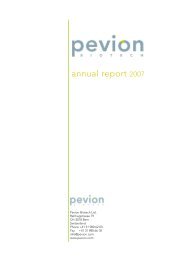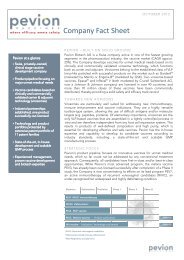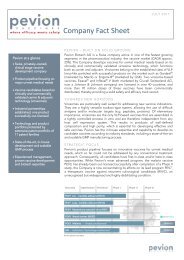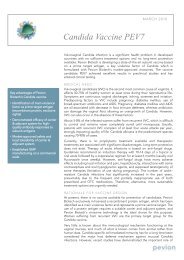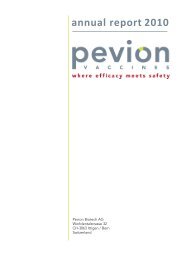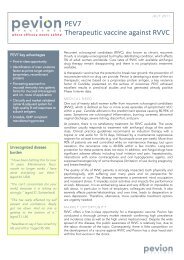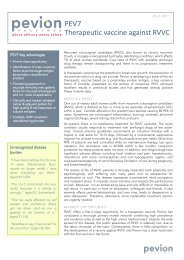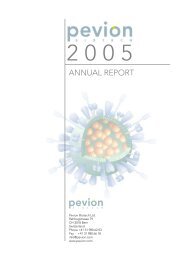Create successful ePaper yourself
Turn your PDF publications into a flip-book with our unique Google optimized e-Paper software.
<strong>2008</strong> ANNUAL REPORT 8<br />
V I R O S O M E - B A S E D T E C H N O L O G Y<br />
<strong>Pevion</strong>_<strong>Biotech</strong>_<strong>annual</strong>_<strong>report</strong>_<strong>2008</strong>_final.docx<br />
<strong>2008</strong> A N N U A L R E P O R T<br />
Virosomes are a market-approved carrier system for the delivery of<br />
immunologically active substances, allowing the correct spatial presentation<br />
of peptides and proteins and facilitating delivery of antigens. Therefore<br />
virosomes act as carrier and adjuvant.<br />
Virosomes consist of<br />
reconstituted empty influenza<br />
virus envelopes devoid of the<br />
nucleocapside, including the<br />
genetic material of the source<br />
virus. They are not able to<br />
replicate, but rather are pure<br />
fusion-active vesicles. In<br />
Influenza virus Virosome<br />
contrast to liposomes,<br />
virosomes contain functional<br />
viral envelope glycoproteins:<br />
influenza virus hemagglutinin and neuraminidase intercalated in the<br />
phospholipid bilayer membrane.<br />
The unique properties of virosomes partially relate to the presence of these<br />
glycoproteins. Not only do they confer structural stability and homogeneity<br />
to virosome formulations, but they significantly contribute to the<br />
immunological properties of virosomes, which are clearly distinct from other<br />
liposomal and proteoliposomal carrier systems. These proteins enable the<br />
virosome membranes to fuse with cells of the immune system and thus<br />
deliver their contents – the specific antigens – directly to their target cells,<br />
eliciting a specific first-class immune response even with weak-immunogenic<br />
antigens. Once they have delivered the antigens, the virosomes are<br />
completely metabolized. Conventional adjuvants like aluminum cannot be<br />
degraded by the body.<br />
M A N U F A C T U R I N G O F V I R O S O M E S<br />
In <strong>2008</strong> <strong>Pevion</strong> <strong>Biotech</strong> developed techniques to optimize synthetic multiepitope<br />
antigens and to attach antigens to virosomes after the formulation.<br />
Both techniques will reduce the manufacturing effort while keeping the<br />
optimal immune responses.<br />
Furthermore, fee-for-service activities were supplied by the technology<br />
group. In <strong>2008</strong> <strong>Pevion</strong> <strong>Biotech</strong> delivered customized formulations to several<br />
companies.<br />
Principle of lyophilization<br />
Working with synthetic peptides or recombinant proteins often has the<br />
disadvantage of limited stability. In addition, vaccines are temporarily<br />
exposed to elevated temperatures that cause losses in vaccine efficacy.<br />
Lyophilization (freeze-drying) is a process that is especially useful for<br />
enhancing stability for long-term storage of biological materials such as<br />
proteins and vaccines, and it can make refrigerated storage obsolete for<br />
normally temperature-sensitive materials. However, conventional "first<br />
generation" virosomes cannot be lyophilized without loss of<br />
immunogenicity, particle size homogeneity and the functional activity of the<br />
influenza HA. Therefore, <strong>Pevion</strong> <strong>Biotech</strong> has developed a new generation of<br />
virosomes which are able to induce strong immune responses and which<br />
feature improved storage and stability properties. This is combined with a<br />
simple and fast preparation method that offers a great flexibility in<br />
combining several specific antigens of choice while retaining the adjuvant<br />
properties and the excellent safety profile.



